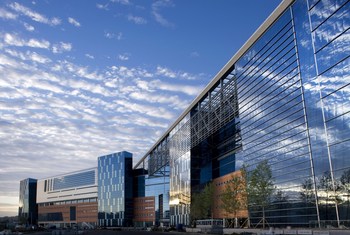Garden 5 Tool
Sep 22, 2011DeStefano Partners, Samoo Architects & Engineers
Samoo Architects & Engineers
2011
Seul, South Korea
Mixed use
Website URL
Wrong or incomplete information? Let us know!
Notes
Originally called the Dongnam Distribution Center (DDC), the recently renamed Garden 5 Tool complex is a mega-shopping center in Seoul, South Korea. The structure was designed by DeStefano Partners of Chicago, Illinois in conjunction with Samoo Architects & Engineers as the associate architect.
Garden 5 Tool is located on a 258,720sf site along the north bank of the Jang-Ji River in Seoul. With over 1,500 shops on site, the complex tips the scales at nearly 3 million square feet of space and consolidates a variety of industrial goods retailers that were formerly sited throughout the central city. In addition to the retail component of the program, Garden 5 Tool also contains a supplementary facility containing a fitness center, food court, and office space.
According to the architect, the building design was driven by a number of physical influences, including the structure’s proximity to various transportation hubs. A highway that runs diagonally along the west and south façades creates a high visibility factor, while Garden 5 Tool’s proximity to the Seoul Airport restricts building heights in the area to 50.7m (about 10 stories). The resulting architectural scheme is a 15-story structure, 10 of which are above grade. Above-grade program includes four levels of retail space, three levels of parking and storage, and another three levels of supplementary facility spaces at the top of the building. Below-grade program accommodates 1,800 parking spots over three levels and two more levels of additional retail space.
The building features a structure comprised of precast concrete and steel, clad in sheet aluminum, tinted insulating glass, and ceramic tile panels to create a visual dynamism in keeping with the dynamic nature of the adjacent stream. The building’s aluminum cladding was conceptualized to echo the water’s curving path and perpetual fluidity.










